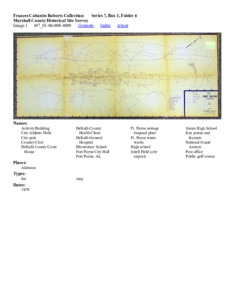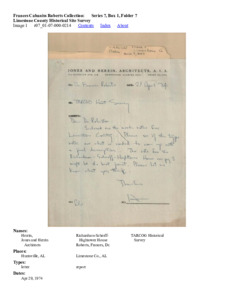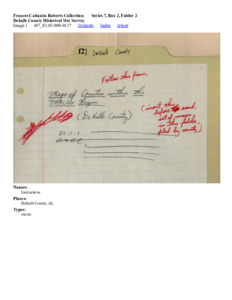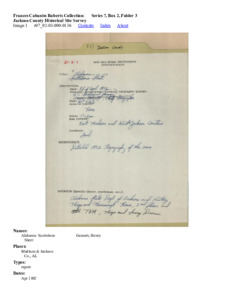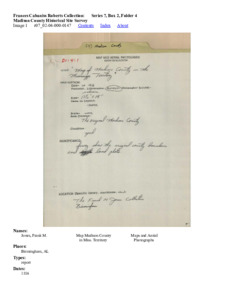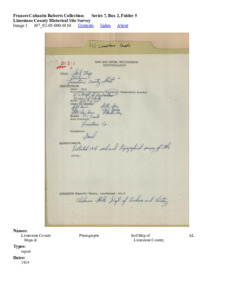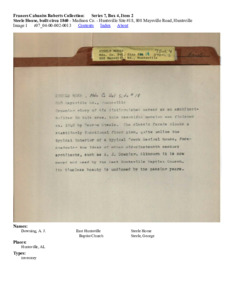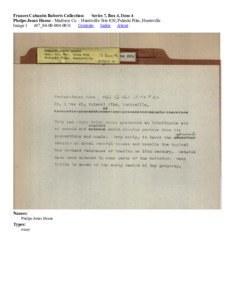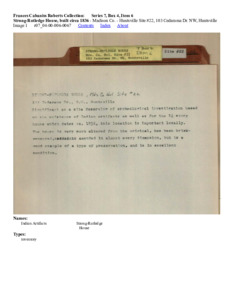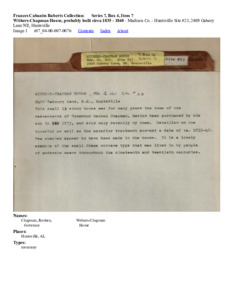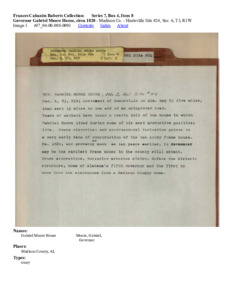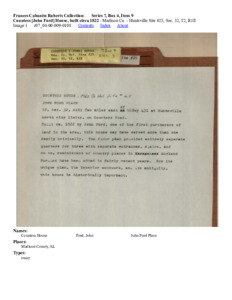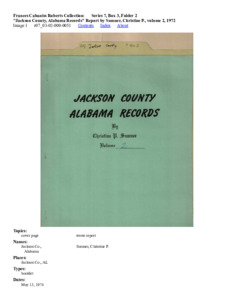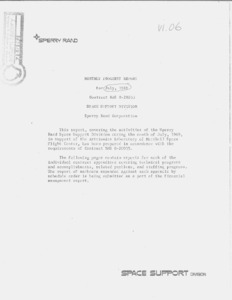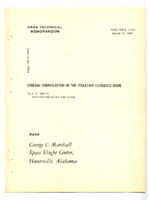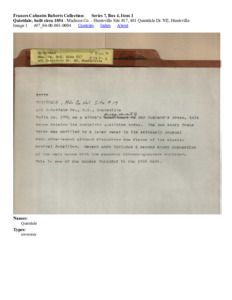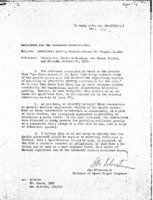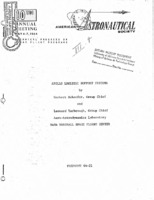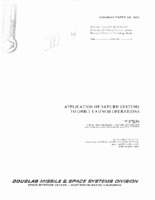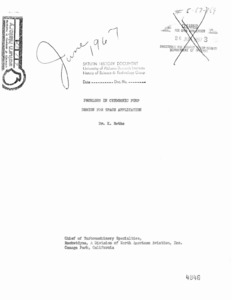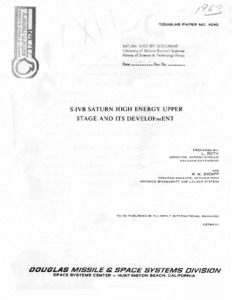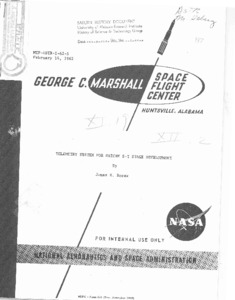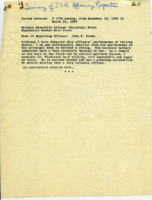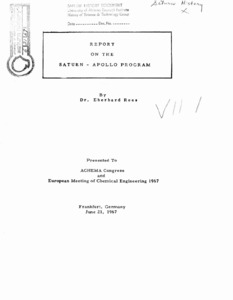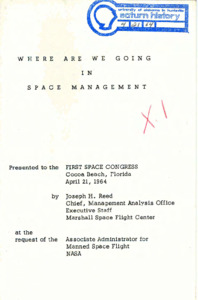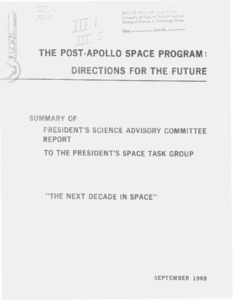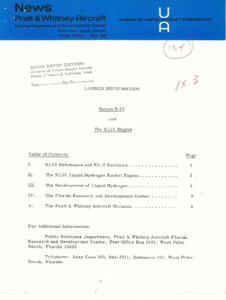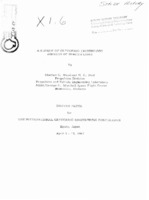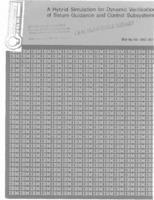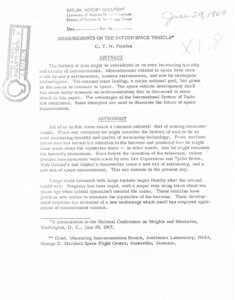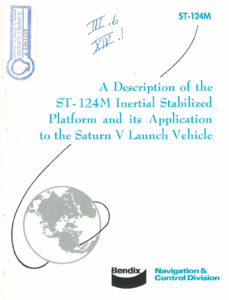
Browse Items (192 total)
Sort by:
-
Marshall County Historical Site Survey
This section contains documents, maps and reports, both handwritten and not related to the Marshal County Historical Site survey. -
Limestone County Historical Site Survey
This section primarily contains handwritten reports and applications for certain buildings / sites to be considered Historic buildings / sites related to the Limestone County Historical Survey. Applications contain descriptions and historic context to justify their admittance. -
Dekalb County Historical Site Survey
This section contains a handful of reports related to photographs (not present), describing their size, significance and additional descriptive details. -
Jackson County Historical Site Survey
This section contains reports related to the Jacksonville Historical Site Survey. Relates specifically to photographs taken of different types of maps. Photographs not included. -
Madison County Historical Site Survey
This section contains reports and maps related to the Madison County Historical Site Survey. Maps appear to be hand-drawn. Contains reports and maps from Madison County, Mississippi and Madison County, Alabama. -
Limestone County Historical Site Survey
This section contains reports related to the Limestone County Historical Survey. Relates specifically to maps and soil maps, including descriptions and historical significance. Maps and Soil Maps not included. -
Historical Survey Preliminary Documents
This section appears to be a collection booklet of TARCOG correspondence, job descriptions, employee/management registers and survey forms. Contains maps paired with certain survey reports. -
Steele House, built circa 1840
This section contains a report on the Steele House, a home built in Madison county, Huntsville, Alabama. -
Phelps-Jones House
This section contains a report on the Phelps-Jones House, a home built in Madison county, Huntsville, Alabama. -
Steele-Gaines House, modified circa 1903
Madison Co. - Huntsville Site #21, 519 Randolph Ave. SE, Huntsville -
Strong-Rutledge House, built circa 1836
This section contains a report on the Strong-Rutledge House, a home built in Madison county, Huntsville, Alabama. -
Withers-Chapman House, probably built circa 1835 - 1840
This section contains a report on the Withers-Chapman House, a home built in Madison county, Huntsville, Alabama. -
This section contains a report on the Gabriel Moore House, a home built in Madison county, Huntsville, Alabama.
Madison Co. - Huntsville Site #24, Sec. 6, T3, R1W -
Countess [John Ford] House, built circa 1822
This section contains a report on the Countess [John Ford] House, a home built in Madison county, Huntsville, Alabama. -
"Automated PCM Data Processor Theory of Operation."
Includes a blueprint of DDAS System Block Diagram. -
Jackson County, Alabama Records Report by Sumner, Christine P., volume 2, 1972
This section contains a report booklet written by Christine P. Sumner. Contains numerous census lists that cover death-rates, land-lists and assessments. -
"Army Participation in the National Satellite and Space Program."
This paper, which was presented at a Semi-Annual Meeting of the American Rocket Society, traces the role of the United States Army in national space activities. Incorporated in the report are photographs illustrating the evolution of the satellite and space program. -
"Statistical model for Saturn electrical support equipment mission availability."
This report presents the logic leading to a mathematical expression for mission availability. Mission availability is treated as the probability that the cumulative downtime occurring during a mission of given length will be less than the time constraint. This is opposed to more general approaches such as steady state or instantaneous availability or operating time versus real time. We intend to present a practical and usable mathematical model by deduction and demonstration. The development is based on exponentially distributed downtimes. Experience shows that certain systems follow exponential downtime distributions except near zero. This error is often so small that it may be neglected. A future report will present a downtime distribution which will account for this small error. -
"The TV system for the Apollo telescope mount."
Focuses on the construction and future use of the Apollo space telescope. The components described in this paper except for those listed otherwise were designed by the Space Support Division of Sperry Rand Corporation to specifications established by NASA's Marshall Space Flight Center in Huntsville, Alabama. Appreciation is extended to MSFC for permission to publish this paper and for data and help provided for its preparation. -
"Sperry Rand monthly progress report for July, 1969."
The following pages contain reports for each of the individual contract appendices covering technical progress and accomplishments, related problems, and staffing progress. The report of manhours expended against each appendix by schedule order is being submitted as a part of the financial management report. -
"The Case for Compatibility."
"The Case for Compatibility" is a paper by Robert L. Smith, Jr., who worked in Quality and Reliability Assurance Laboratory at George C. Marshall Space Flight Center. The summary states, "Ever since the use of missiles and space launch vehicles began, questions have existed in every program regarding the similarity between upstream (e.g., manufacturing, static firing ) and launch site checkout equipment. Programs have existed which utilized nearly identical equipment for both uses; other programs have existed in which any resemblance of the equipment was probably coincidental. Many factors have entered the final decisions, not the least of which were economic and schedule considerations, and, in some instances, the organizational structure of the developer." -
"General Formulation of the Iterative Guidance Mode."
From the abstract: "This report discusses the iterative guidance mode and its application to three-dimensional upper stage vacuum flight. It is an inertial or closed system mode in that the only inputs required after liftoff are available from the onboard navigation system. That is, the iterative scheme computes steering commands as a function of the state and of the vehicle - velocity, position, longitudinal acceleration, and gravitational acceleration - and the desired cutoff conditions. The guidance commands are updated each guidance cycle, using the updated state of the vehicle. The iterative guidance scheme is a path adaptive guidance scheme in that it will retain its optimization properties under all expected types and magnitudes of vehicle perturbations without any loss in accuracy at liftoff." -
Quietdale, built circa 1854
This section contains a report on Quietdale, a home built in Madison county, Huntsville, Alabama. -
"Memorandum for the Associate Administrator: Artificial Gravity Considerations for Project Apollo."
This memorandum contains artificial gravity considerations for Project Apollo and was directed to Seamans, Wernher von Braun, Donlon, and Gilruth. Silverstein writes that he believes it is too early to tell if the Apollo spacecraft is capable of providing artificial gravity. -
Memorandum to update the "Apollo/Saturn Logistics Support Requirements Plan."
This memorandum contains the pages to be changed in the logistics program for the Apollo/Saturn Project. The logistics plan includes the design, procuring, manufacturing, and production processes. This plan formalizes the program, improves logistic support, and implements management and action plans. -
"Apollo Logistic Support Systems."
According to an abstract found on the page following the title page, this paper includes "one possible conceptual definition of an early Apollo Logistics Support Systems (ALSS) is presented and various payloads for the system are briefly discussed. " It also discusses the Lunar Mobile Laboratory (MOLAB) and other considerations for a lunar scientific mission. -
"Application of Saturn Systems to Orbit Launch Operations."
Presented at the AIAA/AAS Stepping Stones to Mars Meeting, this paper compares the "payload velocity spectrum for existing and future missions" with Saturn V capabilities. -
"Problems in cryogenic pump design for space application."
Report detailing the problems surrounding cryogenic pump design for space travel and missions. -
"S-IVB Saturn high energy upper stage and its development."
The development of carrier rockets For manned space missions has been one of the major activities in the aerospace field during the past decade. The early space efforts were made possible by the existence of large ballistics missiles. It soon became obvious that the delivery of weapons and the launch of large spacecraft could not be combined into one operational system in an efficient way; therefore, a family of spacecraft boosters had to be created. -
"Telemetry system for Saturn S-I stage development."
The telemetry system used on the Saturn S-I stage for the transmission of vehicle test data is described. Multiplex and modulationtechniques such as PAM/FM/FM, SS/FM and PGM are used in the system. The diverse data requirements for developing the eight-engineliquid-fueled stage necessitated the use of a combination of severalmodulation techniques to efficiently handle the data. A cursory comparisonis made of the merits of each technique. Physical and electricalrequirements and characteristics of the system are outlined. -
"Summary of JCN Efficiency Reports."
Written by John F. Roehm, this report covers a summary of reports of Colonel John C. Nickerson, Jr.'s efficiency from his former Battery Executive Officer and regimental basketball boach. -
"Report on the Saturn-Apollo program."
Presented to ACHEMA Congress and European Meeting of Chemical Engineering 1967, Frankfurt, Germany, June 21, 1967 by Dr. Eberhard Rees.; Includes slide numbers. -
"Approach in Achieving High Reliability for Saturn Class Vehicles."
This paper focuses on an approach for achieving high reliability within the Navigation, Guidance, and Control systems of the Saturn class launch vehicles. -
"Where are we going in space management."
Presented to the First Space Congress, Cocoa Beach, Florida, April 21, 1964 by Joseph H. Reed, Chief, Management Analysis Office, Executive Staff, Marshall Space Flight Center at the request of the Associate Administrator for Manned Space Flight, NASA -
"Post-Apollo space program report: directions for the future."
Summary of President's Advisory Committee report to the President's Space Task Group. -
"Launch Information: Saturn S-IV and the RL10 Engine."
The RL10, which powers the National Aeronautics and Space Administration' s Saturn S-IV, is the newest propulsion system to be put to work in advancing our nation's space effortr On November 27, 1963, a pair of RLlO's successfully powered a five-ton Centaur space vehicle in earth orbit in the first flight demonstration of the outer space powerplant which uses high-nenergy liquid hydrogen as fuel. A six-engine cluster of RLlO' s, generating a total of 90, 000 pounds of thrust, powers the Saturn S-IV stage. The 15, 000 pound-thrust engine was designed and developed for NASA's Mar shall Space Flight Center at Pratt & Whitney Aircraft's Florida Research and Development Center, 20 miles northwest of West Palm Beach. -
"A Review of Cryogenic Technology Aspects of Space Flight."
This paper was presented at the International Cryogenic Engineering Conference in Kyoto, Japan. It details the use of cryogenic technology in rocketry and how its usage created "many new techniques and deeply stimulated many fields of cryogenic technology." -
"A Hybrid Simulation for Dynamic Verification of Saturn Guidance and Control Subsystems."
This paper presents a discussion of a hybrid simulation used to dynamically verify the Saturn Guidance and Control subsystems. First, the Saturn vehicle is briefly described to provide background information. The Instrument Unit (IU) is considered in more detail to give a proper setting for the Guidance and Flight Control (G and FC) discussion that follows. After a brief description of the actual G and FC System operation, simulation models of the G and FC components are considered in detail. This is followed by a discussion of the model assignment to a particular computer (digital or analog) and justification for making that assignment. Finally, results of the AS-204/LM1 hybrid simulation studies are briefly considered with mention of the actual flight data. -
"Measurements on the Saturn space vehicle."
The history of man might be considered as an ever increasing quantity and quality of measurements. Measurements related to space have been made by early astronomers, modern astronomers, and now by aerospace technologists. The manned lunar landing, a major national goal, has given us the means to measure in space. The space vehicle development itself has made heavy demands on instrumentation; this is discussed in some detail in this paper. The advantages of the International System of Units are mentioned. Some examples are used to illustrate the future of space measurement. -
"A description of the ST-124M inertial stabilized platform and its application to the Saturn V launch vehicle."
This report is a description of the ST-124M inertial stabilized platform system and its application to the Saturn V launch vehicle. It is a summary report providing the system concept, and not a theoretical presentation. Mathematical equations were included only where necessary to describe the equipment; however, the detailed derivations supporting these equations were not presented since this was not the theme of the paper.
